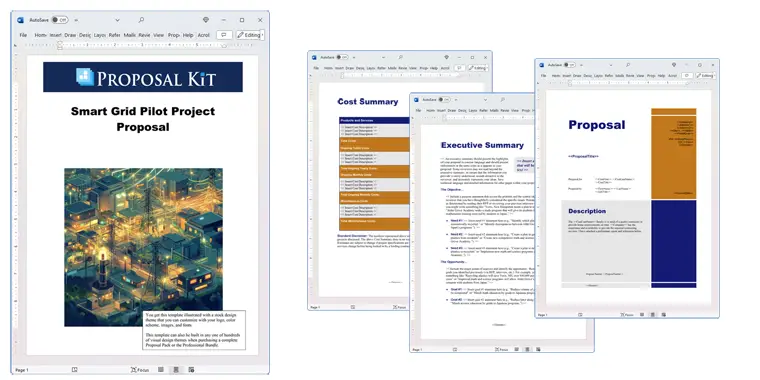How to write your Smart Grid Pilot Project Proposal
We include this 34 page layout with every Proposal Pack. If you want this template to have a different visual design theme than the one illustrated here, purchase any Proposal Pack design and create this template using the purchased design theme. This template is included in every Proposal Pack. If you get a Proposal Pack or the Professional, you can also make any variation of this template with different chapters to suit your needs.
We typically include more chapters in the templates than most people will need to give everyone more variety in the chapters they may need. You can trim down a long template by removing pages you do not need or combining multiple chapter topics into one page.
 DOWNLOADABLE, ONE-TIME COST, NO SUBSCRIPTION FEES
DOWNLOADABLE, ONE-TIME COST, NO SUBSCRIPTION FEESYou can also create countless variations of this document to suit your needs using the included library of 2200+ chapters if ordering a Proposal Pack or Professional.
 What Our Clients Say
What Our Clients SayProposal Pack Wizard works great with Microsoft Office and Proposal Kit Professional. Using the Wizard to keep my files organized and looking professional helps my end results. My clients love the professional format and the clarity of my documents. That would only be possible thanks to both Proposal Kit and the Proposal Pack Wizard. The ease of use of both of these products makes working with proposals very fast and efficient use of my time."
The MacExperience, Inc.
Related Article
Related Video
Related Templates
- Energy Efficiency Grant Project Proposal
- Electrical Engineering Project Proposal
- Electrical System Upgrade Proposal
- Electrical Contractor Proposal
- Facilities Management Proposal
- Civil Engineering Construction Project Proposal
- Pilot Project Proposal
- Sustainable Power for Eco Resort Proposal
- Steel Erection Project Proposal
- Retrofit Project Proposal
- Equipment or Machinery Systems Upgrade Proposal
What's the best way to write your smart grid pilot project proposal?
A proven solution to creating a smart grid proposal is to use the Proposal Kit template library and Wizard software program. These tools are designed to provide you with a proven method for developing comprehensive, professional, and winning proposals. The Proposal Kit not only offers a wide array of customizable templates but also integrates a line item quoting database system. This feature is important for creating detailed cost summaries, quotes, estimates, budgets, and other financial documents that are crucial for any proposal.
Do you need to write a proposal for a smart grid pilot or a similar project? Proposal Kit is tailored for your needs.
What Types of Projects Are Smart Grid Pilot Project Proposal Written For?
Smart grid proposals are often required for a variety of initiatives aimed at using advanced technology to enhance energy efficiency, reliability, and sustainability. Here are some examples of projects for which such proposals are typically written:
- Installation of smart meters across a community
- Development of renewable energy sources, like solar or wind
- Implementation of demand response programs
- Grid modernization efforts
- Integration of electric vehicle charging stations
- Deployment of energy storage systems
- Enhancement of grid cybersecurity measures
- Introduction of grid-to-building technology
- Development of microgrid systems
- Expansion of distributed energy resources
- Facilitation of energy efficiency programs
- Deployment of advanced distribution management systems
- Creation of a virtual power plant
- Implementation of smart home technology
- Grid automation initiatives
- Community energy sharing projects
- Data analytics for grid optimization
- Upgrade of transmission infrastructure
- Research in grid innovation
- Pilot programs for real-time grid monitoring
Chapters this template is built with
No one-size-fits-all premade template can fit all situations, which is why Proposal Kit software is used for creating custom variations of templates that accommodate every situation. Below is a starting point of chapters that can be customized using the Proposal Kit's extensive content library of thousands of chapters. Here are some examples of how Proposal Kit's templates can be used in a smart grid proposal:
Cover Letter
The cover letter introduces the proposal by briefly summarizing the smart grid initiative, its importance for the local community or organization, and how it addresses specific energy challenges. It sets a professional tone and engages the recipient by outlining the proposal's relevance to their needs and goals.
Executive Summary
This section provides a concise overview of the smart grid project's objectives, including how it will improve energy efficiency, enhance reliability, and promote sustainability. It highlights key methods and anticipated outcomes, offering a snapshot that captures stakeholders' interest and support.
Cost Summary
In this section, detailed financial topics of the project are outlined. This includes a comprehensive budget, cost breakdowns of various components, and funding requirements. It provides transparency by explaining how funds will be allocated, ensuring stakeholders understand the financial scope and feasibility.
Customer Information
This chapter details the customer's or client's specific energy needs, challenges faced, and how the proposed smart grid project aligns with their objectives. It demonstrates a clear understanding of the customer's current situation and how the solution will provide tangible benefits.
Next Steps
Defines the immediate actions required once the proposal is approved, such as project initiation meetings, resource allocation, and stakeholder notifications. This ensures all parties are aligned and prepared to move forward efficiently with the project implementation.
Goals and Objectives
Outlines the smart grid project's specific aims, such as reducing energy consumption by a certain percentage, increasing grid reliability, and integrating renewable energy sources. It establishes clear metrics for success and aligns them with broader energy goals and policies.
Scope
This section specifies the boundaries of the project, detailing what is included, such as specific technologies or pilot areas, and what is excluded. It identifies constraints and limitations, helping to manage expectations and focus resources on achievable outcomes.
Action Plan
Provides a detailed, step-by-step guide on how the project will be executed. This includes timelines for each phase, resource allocation, and roles and responsibilities of team members. It ensures that all participants have a clear roadmap to follow and can coordinate.
Marketing Plan
Explains strategies for promoting the smart grid project to stakeholders and the wider public. It includes methods for raising awareness, gaining support, and communicating benefits, ensuring the project garners the necessary buy-in and enthusiasm.
Site Selection
Details the criteria for choosing the project locations, such as areas with high energy demand or existing infrastructure. It justifies the selected sites based on advantages, such as cost-effectiveness or potential for impact, ensuring optimal project outcomes.
Approach
Describes the methodologies and techniques to be used, such as advanced data analytics or new grid technologies. Showcases how these innovations will enhance efficiency and performance, setting the project apart as forward-thinking and effective.
Strategy
Outlines the high-level plan for achieving the project's goals, detailing key initiatives like technology deployment and stakeholder engagement. It explains the expected impacts of these initiatives, providing a framework for the project's execution.
Deployment
Outlines the logistical process for rolling out project components, minimizing disruption by detailing phased implementations or temporary measures. It ensures smooth execution by addressing potential challenges and outlining contingency plans.
Outreach
Discusses plans for engaging stakeholders, including community groups, government entities, and the public. It includes strategies for communicating project benefits, addressing concerns, and fostering collaboration to ensure widespread support.
Reinvestment
Explains how the project will generate financial returns or other benefits that can be reinvested into further energy initiatives. It outlines mechanisms for capturing these returns, such as cost savings or revenue from energy sales, promoting long-term sustainability.
Project Background
Provides context by explaining the history and necessity of the project, such as past energy challenges or regulatory changes. It underscores the project's significance within the industry, setting the stage for its importance and urgency.
Service Area
Defines the geographic scope of the project, detailing the areas to be impacted and served by the smart grid initiatives. It ensures stakeholders understand the project's reach and the communities or regions that will benefit from the enhancements.
Phases
Breaks down the project lifecycle into manageable phases, each with specific deliverables and timelines. This phased approach helps manage complexity, allows for incremental progress checks, and facilitates adjustments as needed.
Scalability
Describes the project's potential for future expansion, such as integrating additional technologies or expanding to new areas. It ensures the project's design is flexible and can accommodate growth, enhancing its long-term viability.
Security
Details comprehensive measures to protect the project from cyber threats, such as encryption protocols and access controls. It ensures data integrity and confidentiality, maintaining trust among stakeholders and adhering to regulatory standards.
Technology
Lists the technological components involved, highlighting innovations such as smart meters or IoT devices. It emphasizes cutting-edge solutions and their role in achieving the project's objectives, positioning the project as technologically advanced.
Hardware and Software
Details the specific hardware and software solutions to be used, ensuring they are compatible and efficient. It provides technical specifications and integration plans, ensuring the system operates seamlessly and meets performance standards.
Pilot Program
Explains the small-scale testing of the project before full implementation, reducing risk by allowing for adjustments based on initial findings. It outlines the pilot's objectives, methods, and evaluation criteria, ensuring thorough vetting of the approach.
Leverage
Describes how existing resources, such as infrastructure or partnerships, will be used to enhance project efficiency. It demonstrates resourcefulness by maximizing current assets, reducing costs and improving implementation speed.
Monitoring
Outlines systems for tracking project progress and performance, such as performance metrics and reporting tools. It enables timely adjustments through regular reviews and feedback loops, ensuring the project remains on track and meets its goals.
Economic Cost
Analyzes the project's financial implications, including potential cost savings from reduced energy consumption or efficiency gains. It provides a detailed financial model, offering stakeholders a clear picture of the economic benefits and costs.
Cost Savings
Highlights anticipated financial savings from the project, such as reduced operational costs or lower energy bills. It provides financial justification by quantifying these savings and demonstrating the project's return on investment.
Recommendations
Offers expert suggestions for project improvement and optimization, drawing on industry best practices and lessons learned. It provides actionable insights for enhancing project outcomes, ensuring ongoing refinement and success.
Capacity
Details the project's ability to handle current and future energy demands, ensuring it can meet reliability and performance standards. It includes capacity assessments and plans for scaling, addressing potential bottlenecks or limitations.
Future Potential
Explores the long-term benefits and possibilities the project could unlock, such as new technology integration or expanded service areas. It makes a case for the project's adoption by highlighting its potential to transform energy systems and deliver sustained value.
Principles
Describes the fundamental guiding principles and values underpinning the project, such as sustainability and ethical practices. It aligns the project's objectives with broader societal and environmental goals, ensuring responsible and impactful implementation.
Use cases for this template
Transforming City Grids with Advanced Microgrid Implementation
The Challenge
Electric Innovations Corp was presented with a significant opportunity: the chance to revolutionize a local city's energy infrastructure by implementing an advanced microgrid system. However, the challenge lay in articulating the intricate technical details and demonstrating the substantial financial benefits required by the city's Request for Proposal (RFP). Alex, the lead project manager, found himself overwhelmed by the complexity involved in converting the technical jargon into a coherent and compelling narrative that could win the contract.
The Solution
Recognizing the need for a structured approach, Alex turned to Proposal Kit. The software offered a comprehensive template library specifically designed for energy projects, including the important line item quoting database. This feature enabled Alex to develop a detailed proposal that communicated the technical and financial advantages of the microgrid system. By outlining the cost savings and operational efficiency gains, Alex was able to create a proposal that resonated with city officials.
The Implementation
With Proposal Kit's tools, Alex customized the templates to align with the specific needs of the microgrid project. He integrated detailed data and financial metrics, showcasing the feasibility and value of the proposed system. Alex highlighted how the microgrid would enhance energy resilience, reduce emissions, and create cost efficiencies - key priorities for the city. The Proposal Kit's structured approach enabled Alex to transform his technical expertise into a seamless narrative.
The Outcome
The created proposal was well-received, resulting in Electric Innovations Corp securing the contract. Alex's efforts were instrumental in leading the implementation of the state-of-the-art microgrid system, significantly boosting the city's energy efficiency and resilience against future power disruptions. The success of the project not only bolstered the city's infrastructure but also positioned Electric Innovations Corp as a trusted partner in smart energy solutions.
Meeting Tight Deadlines for Smart Home Innovation
The Challenge
Samantha, at SmartTech Solutions, was tasked with a project: to write a proposal for an internal smart home technology pilot project. The deadline was tight, with only a few weeks to present a case that would convince the management team of the project's potential. The pressure was on to deliver a well-structured and persuasive proposal within the limited timeframe.
The Solution
Samantha decided to leverage Proposal Kit to streamline the proposal writing process. By using the platform's customizable templates, she was able to quickly organize her thoughts and structure the proposal. Additionally, the integration of AI writing tools allowed Samantha to write content efficiently. She cleverly used AI to analyze SmartTech's website for relevant material, which provided valuable insights and content for key chapters of the proposal.
The Implementation
With Proposal Kit, Samantha focused on refining the proposal rather than starting from scratch. The AI writing tools generated initial drafts for crucial sections, such as the Executive Summary and Approach, allowing Samantha to focus on clarity and precision. By focusing on enhancing these drafts, she was able to articulate the project's innovative topics and the expected benefits to the company. The software's structured format facilitated a cohesive presentation of the proposal.
The Outcome
Samantha successfully met the challenging deadline, submitting a polished and professional proposal that left a lasting impression on SmartTech Solutions' decision-makers. Her use of Proposal Kit's tools and AI assistance produced a comprehensive plan that underscored the value of smart home technology. The proposal was approved for implementation, marking a significant milestone in Samantha's career and setting the stage for SmartTech's next technological advancement.
Securing Partners for Solar Power Integration
The Challenge
Jordan, a director at a non-profit dedicated to renewable energy, faced the crucial task of writing an RFP for a pilot program aimed at integrating solar power into community homes. The central challenge was to attract innovative solutions from potential partners who shared the non-profit's vision for sustainable energy. Creating an RFP that clearly communicated the project's goals and expectations required careful consideration and precision.
The Solution
To address this challenge, Jordan opted for Proposal Kit, a tool known for its extensive collection of templates that cater to the renewable energy sector. Armed with this resource, Jordan was able to construct a detailed and compelling RFP. The templates ensured that the project scope and objectives were clearly defined, making the document appealing to potential partners who could offer innovative solutions and align with the non-profit's mission.
The Implementation
With Proposal Kit, Jordan tailored the templates to reflect the unique mission and goals of the non-profit. The structured format allowed for a clear articulation of the desired outcomes and evaluation criteria. By incorporating specific metrics and benchmarks, Jordan ensured that the RFP was comprehensive and clear, encouraging a wide range of vendors to submit their proposals.
The Outcome
The thoughtfully created RFP garnered attention from several leading companies in the renewable energy sector. Jordan received multiple innovative proposals, ultimately selecting a partner that perfectly aligned with the non-profit's objectives. This collaboration led to the successful implementation of the solar power project, significantly advancing the non-profit's mission to promote renewable energy solutions within the community. The project stood as a testament to the power of clear communication and partnerships in driving sustainable change.
Conclusions and Recommendations
Creating a smart grid proposal is an important step in winning bids and securing contracts. Proposal Kit provides a proven solution for developing such proposals. From its library of customizable templates to its integrated quoting database, Proposal Kit equips you with the tools necessary to tackle any proposal writing challenge. Whether you're responding to an RFP for a smart grid pilot project or pitching an internal initiative, Proposal Kit streamlines the process, ensuring your proposal is comprehensive, professional, and persuasive.
Also Known As
This template may also be referred to in different ways or be used in more specialized situations, such as:
- Smart Energy Initiative Proposal
- Grid Modernization Project Plan
- Renewable Energy Proposal
- Energy Efficiency Project Proposal
- Power Grid Pilot Plan
- Advanced Grid Proposal
- Smart Meter Installation Proposal
- Microgrid Integration Plan
- Sustainable Energy Project Proposal
- Grid Automation Project Proposal
Abstract
 Smart grid pilot projects are important for modernizing energy infrastructure and addressing challenges such as power outages, rising energy demand, and the need for increased efficiency. These projects focus on integrating advanced technologies like smart meters, renewable energy sources, and microgrid systems to improve grid reliability, capacity, and sustainability. By implementing solutions such as data analytics, grid automation, and energy storage, smart grid initiatives aim to reduce operational costs, offer significant cost savings, and support the expansion of distributed energy resources.
Smart grid pilot projects are important for modernizing energy infrastructure and addressing challenges such as power outages, rising energy demand, and the need for increased efficiency. These projects focus on integrating advanced technologies like smart meters, renewable energy sources, and microgrid systems to improve grid reliability, capacity, and sustainability. By implementing solutions such as data analytics, grid automation, and energy storage, smart grid initiatives aim to reduce operational costs, offer significant cost savings, and support the expansion of distributed energy resources.
A well-developed smart grid pilot project proposal clearly defines project goals and objectives, outlines economic costs, and demonstrates the future potential for scalability and reinvestment. The proposal also highlights security measures, hardware and software integration, and strategies for monitoring and outreach, ensuring stakeholder engagement and public support. Using a structured Proposal Kit helps organizations assemble comprehensive proposals with detailed financial planning, complex document assembly, and customizable content libraries. These proposals are crucial in securing contracts for grid modernization, addressing issues such as power outages, and paving the way for sustainable energy solutions that transform community energy systems.
As cities and organizations face increasing pressure to reduce energy consumption, prevent power outages, and meet modern sustainability standards, smart grid pilot project proposals have become vital instruments for driving change. These proposals not only lay the groundwork for the installation of innovative systems - such as grid-to-building technology, virtual power plants, and advanced distribution management - but also help communities respond to regulatory changes and energy policies. By defining a clear service area, providing a phased action plan, and presenting robust recommendations, these projects demonstrate their capacity to deliver measurable improvements in grid reliability and resilience.
 Writing a winning proposal involves more than just technical detail; it requires communicating complex concepts to a diverse audience, including city officials, utility partners, and community stakeholders. Comprehensive proposals must address concerns about security, outline marketing strategies to build support and include clear cost summaries that reinforce the project s economic feasibility. The use of Proposal Kit helps teams to efficiently tailor documents for various project types and audiences, ensuring that each proposal addresses unique customer information and specific local challenges.
Writing a winning proposal involves more than just technical detail; it requires communicating complex concepts to a diverse audience, including city officials, utility partners, and community stakeholders. Comprehensive proposals must address concerns about security, outline marketing strategies to build support and include clear cost summaries that reinforce the project s economic feasibility. The use of Proposal Kit helps teams to efficiently tailor documents for various project types and audiences, ensuring that each proposal addresses unique customer information and specific local challenges.
For organizations, a thoughtfully created smart grid proposal can secure critical funding, attract experienced partners, and spark innovation across the energy sector. By emphasizing future potential and aligning with guiding principles like environmental responsibility, these proposals not only target the reduction of power outages and operational costs but also foster public trust and long-term community engagement. Ultimately, high-quality smart grid pilot project proposals set the stage for energy systems that are safer, smarter, and better equipped to meet the challenges of tomorrow.
In addition to addressing immediate concerns such as power outages and cost savings, smart grid pilot project proposals also play an important role in preparing communities for the rapid adoption of electric vehicles, increased renewable energy integration, and the growing need for cybersecurity in critical infrastructure. These proposals often include detailed site selection criteria, ensuring that investments are made in locations where they will achieve the greatest impact for both grid stability and community benefit.
 By pitching scalable solutions, smart grid projects enable gradual expansion, allowing for lessons learned during pilot programs to inform broader rollouts. This approach minimizes risk and maximizes resource leverage, as organizations can use existing infrastructure and partnerships to accelerate project timelines and reduce overall economic costs. The inclusion of monitoring and performance metrics ensures continuous improvement, while outreach efforts actively involve local residents and businesses, promoting transparency and collaboration throughout the project lifecycle.
By pitching scalable solutions, smart grid projects enable gradual expansion, allowing for lessons learned during pilot programs to inform broader rollouts. This approach minimizes risk and maximizes resource leverage, as organizations can use existing infrastructure and partnerships to accelerate project timelines and reduce overall economic costs. The inclusion of monitoring and performance metrics ensures continuous improvement, while outreach efforts actively involve local residents and businesses, promoting transparency and collaboration throughout the project lifecycle.
The process of assembling a smart grid proposal also encourages cross-disciplinary teamwork, bringing together experts from engineering, finance, policy, and community engagement. For the target audience, this means access to proposals that reflect a holistic understanding of technical, environmental, and social dimensions. Using the Proposal Kit not only streamlines this complex process but also enhances the clarity and professionalism of the final document, providing an advantage when competing for grants or contracts. In this way, smart grid pilot project proposals serve as both blueprints for innovation and catalysts for building more resilient and adaptive energy systems in these times of changing demands.
Frequently Asked Questions
What should be the primary focus when writing a smart grid proposal?
When writing a smart grid proposal, the primary focus should be on clearly articulating the benefits and objectives of the project. It is important to demonstrate how the proposed project will enhance energy efficiency, reliability, and sustainability within the grid. The proposal should make a case for the adoption of advanced technologies and outline the expected positive impacts on the community or region. By emphasizing these key areas, you can convey the value and necessity of the project to stakeholders and decision-makers.
How detailed should the financial section be in a smart grid proposal?
The financial section of a smart grid proposal should be both detailed and clear. This section needs to include comprehensive cost breakdowns, estimates, and budget justifications. It's important to clearly show how project funds will be allocated across various components such as technology, infrastructure, and personnel. Additionally, providing cost-benefit analyses and potential cost savings can strengthen the financial argument of your proposal. Addressing these financial details thoroughly can help instill confidence in stakeholders regarding the project's economic feasibility.
What role does technology play in a smart grid proposal?
Technology is a central topic in a smart grid proposal, as it outlines the specific innovations and tools that will be used to modernize the grid. The proposal should detail the types of technology that will be implemented, such as smart meters, data analytics systems, or renewable energy integrations. Describing how these technologies will interact to improve grid functionality and enhance energy management can showcase the project's innovativeness. By clearly articulating the technological topics, the proposal can demonstrate its potential to advance the grid's capabilities.
How can community impact be addressed in a smart grid proposal?
Addressing community impact is crucial in a smart grid proposal, as it highlights the social and economic benefits that the project will bring to the local area. The proposal should detail how the project will improve electricity reliability, reduce outages, lower energy costs, and potentially create job opportunities. Additionally, it can include plans for community engagement and education to ensure local support and participation. By focusing on these impacts, the proposal can align the project's goals with community priorities and gain broader acceptance.
Why is scalability important in a smart grid proposal?
Scalability is an important consideration in a smart grid proposal because it addresses the project's long-term viability and adaptability. The proposal should discuss how the project can be expanded or adapted to meet future demands and technological advancements. This includes outlining plans for potential upgrades, integrations with other systems, and the ability to accommodate increased energy consumption. Highlighting scalability in the proposal demonstrates foresight and ensures that the project is not only a short-term solution but also a sustainable and flexible investment for the future.
20% Off Discount
![]() Add To Cart This Word Template
Add To Cart This Word Template
 Add To Cart Proposal Pack for Any Business
Add To Cart Proposal Pack for Any Business
 Add To Cart Proposal Kit Professional
Add To Cart Proposal Kit Professional
 4.7 stars, based on 849 reviews
4.7 stars, based on 849 reviewsProposal Kit chapters used in this template
Cover Letter, Title Page, Table of Contents, Executive Summary, Project Background, Pilot Program, Goals and Objectives, Security, Approach, Customer Information, Principles, Strategy, Site Selection, Scope, Cost Summary, Economic Cost, Cost Savings, Reinvestment, Next Steps, Service Area, Marketing Plan, Outreach, Scalability, Technology, Hardware and Software, Leverage, Monitoring, Capacity, Future Potential, Deployment, Phases, Recommendations, Action Plan, Back Page
Line Item Automated Chapters
If you purchase a Proposal Pack or the Professional Bundle, these proposal pages are generated using an automated line-item database in the included Wizard software.
Cost Summary
You use this proposal for
- General business proposal
- Technical proposal
- Project pitch proposal
- RFP response
- Construction, contracting, building proposal
- Federal government grant proposal
- IT, software, hardware proposal
- Energy proposal
How to create this template with Proposal Pack Wizard
You can create this document using any of the logo-designed Proposal Packs. Pick any Proposal Pack with a logo design theme you like best; they will all work equally well. The Proposal Pack for Any Business is the pack with no extra added logos or colors - designed to be used plain or for you to customize with your logos and graphics.
The Proposal Pack design theme you purchase will determine the visual look of this template. The screenshot above only shows the plain generic design theme.
We include a library of chapters to be assembled based on your needs. All proposals are different and have different needs and goals. We designed Proposal Pack so you can customize the documents to suit your needs.
You will best create this document using the Proposal Pack Wizard - Expert Edition software to select this template and build it in the Proposal Pack logo design theme of your choice along with any desired customizations (such as adding additional chapters, removing unneeded chapters, changing the order of chapters, and importing your company logo). This template outlines a proposal for the described situation. Each user is responsible for typing in the actual content of the provided pages with their information to complete the proposal. Suggestions in the abstract may include features in higher-end packages and are facilitated by the selection of chapter templates to support the narrative of each proposal, which help guide the user in filling in the details.
The Wizard software's AI Writer will write the content of the pages of the template based on details provided for your company, client, project, financial details and other writing instructions. This will provide a personalized version of the template completely written and ready to edit.
Once finished, the AI Writer's Word-to-PowerPoint converter can transform your proposal, business plan, or other business documents into a PowerPoint slideshow. Save time and effort by letting the AI analyze every chapter to condense its content into talking points, visually matching the document, and providing a consistent package of presentation material with the click of a button.
You create this template using the Wizard software with an entire Proposal Pack library and software. We include the Expert Edition of the software in the Proposal Kit Professional. Microsoft Word for Windows is required to use the customizing software. You can also edit Word document templates in other office software such as Word for Mac. We will assist Mac users in assembling complex templates for their first project if they do not have the required platform to run the Wizard software.
How to Build Templates Featured on Proposal Kit Website
Many people find the Proposal Kit website after searching for a specific proposal. Once you've purchased and installed the software, how do you build that template you found in the first place? This video shows you how to build any proposal you see on the Proposal Kit website.
 Ian Lauder has been helping businesses write their proposals and contracts for two decades. Ian is the owner and founder of Proposal Kit, one of the original sources of business proposal and contract software products started in 1997.
Ian Lauder has been helping businesses write their proposals and contracts for two decades. Ian is the owner and founder of Proposal Kit, one of the original sources of business proposal and contract software products started in 1997.By Ian Lauder
 Published by Proposal Kit, Inc.
Published by Proposal Kit, Inc.


 Cart
Cart
 Get 20% off ordering today:
Get 20% off ordering today: 


 Facebook
Facebook YouTube
YouTube Bluesky
Bluesky Search Site
Search Site